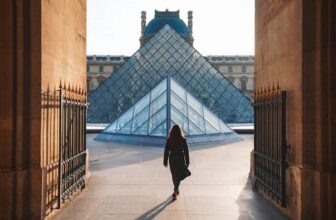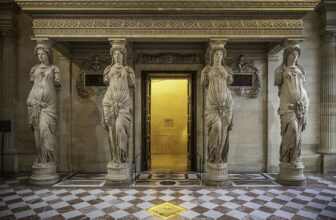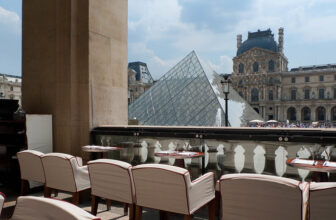
The Louvre’s Connection to The Da Vinci Code
Dan Brown’s best-selling novel The Da Vinci Code catapulted the Louvre into the realm of global mystery and intrigue. The book, a thrilling mix of art, history, and conspiracy, suggests that the museum holds clues to a hidden secret about Jesus Christ and Mary Magdalene, encoded in the works of Leonardo da Vinci. Since its publication in 2003, millions of readers and moviegoers have flocked to the Louvre, eager to trace the footsteps of protagonist Robert Langdon and uncover the supposed mysteries within its walls.
Was The Da Vinci Code Filmed in the Louvre?
Yes, portions of The Da Vinci Code, directed by Ron Howard and starring Tom Hanks as Robert Langdon, were indeed filmed inside the Louvre. The museum granted the film crew permission to shoot scenes inside its grand halls, making it one of the few movies ever allowed such access. The opening sequences, where Louvre curator Jacques Saunière is pursued and ultimately killed inside the museum, were filmed in the Louvre’s Denon Wing. The iconic glass pyramid and the breathtaking Grand Gallery also make prominent appearances in the film, lending authenticity and grandeur to the adaptation of Brown’s novel.
However, some interior shots were recreated on sound stages, as extensive filming inside the museum would have been logistically challenging. Nevertheless, the real-life Louvre remains an essential backdrop to the unfolding mystery, cementing its status as a place of historical and artistic enigma.
Is The Mona Lisa in The Da Vinci Code?
Yes, Leonardo da Vinci’s famous painting, The Mona Lisa, plays a significant role in The Da Vinci Code. In the novel and film, the painting serves as a clue in the cryptic trail left by Jacques Saunière, who positions himself in a symbolic pose resembling Leonardo’s Vitruvian Man before he dies. The Mona Lisa’s enigmatic smile and alleged hidden meanings become central to the story’s overarching theme of secret messages embedded in art.
In one of the novel’s pivotal early scenes, Robert Langdon and cryptologist Sophie Neveu examine The Mona Lisa for clues left by Saunière. On the protective glass covering the painting, they find an anagram and a numerical sequence, which sets them on a journey to uncover the Priory of Sion’s secret. The painting’s real-life mystique, surrounded by speculation regarding hidden codes and secrets, aligns seamlessly with The Da Vinci Code’s narrative, making it one of the novel’s most memorable elements.
The Louvre’s Mystique and Its Connection to the Novel
Beyond The Mona Lisa, the Louvre houses several other artworks that are significant to the plot of The Da Vinci Code. The novel delves into the alleged symbolic meanings hidden within Leonardo da Vinci’s The Last Supper, arguing that the figure to Jesus’ right is not the apostle John but Mary Magdalene. While The Last Supper itself is housed in Milan, the Louvre is depicted as the starting point of the quest for the Holy Grail, a quest that leads Langdon and Sophie to uncover layers of hidden history.
The Louvre’s rich history, dating back to its origins as a fortress in the 12th century before becoming a royal palace and later a museum, makes it the perfect setting for a story centered on ancient secrets and hidden knowledge. The museum’s vast collection of Renaissance art and religious iconography adds weight to the novel’s premise that artistic masterpieces hold encrypted messages waiting to be deciphered.
The Real and Fictional Mysteries of the Louvre
While The Da Vinci Code is a work of fiction, it has sparked widespread curiosity about the real-life mysteries of the Louvre. Some of the questions the novel raises include:
- Does Leonardo da Vinci’s art contain hidden messages? Scholars and art historians debate whether Da Vinci embedded secret codes in his paintings, with some pointing to his interest in mathematics, symmetry, and symbolism.
- Was the Priory of Sion a real organization? Brown’s novel claims that the Priory of Sion was a secret society dedicated to preserving the bloodline of Jesus Christ and Mary Magdalene. However, historical investigations suggest that the Priory of Sion, as presented in the book, is a modern hoax created in the 20th century.
- Is the Holy Grail a literal object or a metaphor? The Da Vinci Code presents the controversial idea that the Holy Grail is not a chalice but rather Mary Magdalene herself, who carried the bloodline of Jesus. This interpretation has intrigued readers and theologians alike, sparking debates about biblical history and symbolism.
Despite the fictional liberties taken in the novel, The Da Vinci Code has undeniably deepened public interest in the Louvre and its treasures, inspiring countless visitors to explore the museum with fresh eyes.
The Enduring Legacy of The Da Vinci Code
Since its release, The Da Vinci Code has left an indelible mark on both the literary and cinematic worlds. The novel’s fusion of history, religion, and art continues to captivate audiences, prompting a surge in tourism to locations featured in the story. The Louvre, in particular, has benefited from the novel’s popularity, with visitors eager to experience the setting firsthand.
Even today, nearly two decades after the book’s publication, The Da Vinci Code remains a cultural phenomenon, blending real historical elements with speculative fiction in a way that keeps readers and moviegoers enthralled. Whether or not one subscribes to the theories proposed in the book, there is no denying its impact on how people perceive art, history, and the Louvre itself.
In the end, The Da Vinci Code transforms the Louvre from a mere museum into a treasure trove of hidden secrets, forever intertwining its legacy with the realm of mystery and adventure. image/wikipedia




